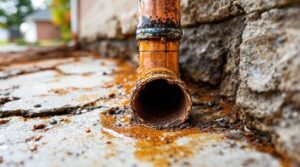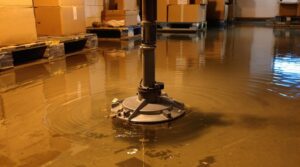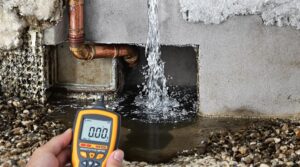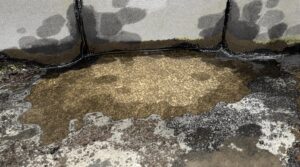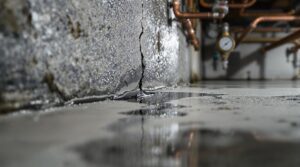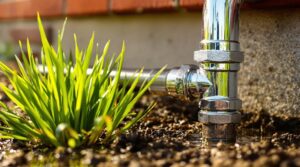Homeowners insurance typically covers water line leaks caused by sudden and accidental events, such as a burst pipe. Policy terms and conditions dictate the extent of coverage. To determine coverage, insurance providers assess the nature of the damage, distinguishing between sudden events and gradual deterioration. Sudden damage is generally covered, while gradual damage is often excluded. Understanding policy specifics is essential for maneuvering through coverage complexities and pursuing potential solutions for uncovered damages.
Key Takeaways
- Homeowners insurance typically covers sudden and accidental water line leaks, but not gradual damage from wear and tear or neglect.
- Policy coverage depends on the source and nature of the leak, with sudden events more likely to be covered.
- Insurance providers assess the damage to determine whether it was sudden or gradual, influencing policy applicability.
- Routine plumbing maintenance and inspections can help identify issues early and reduce the likelihood of extensive damage.
- Reviewing policy documents and past claims can aid in understanding potential coverage for water line leak damage.
What Causes Water Line Leaks and How Can You Prevent Them?
Because water line leaks can result in significant damage to a home, understanding their causes is essential for preventing costly repairs. Common causes of water line leaks include aging pipes, corrosion, and excessive water pressure. Pipes can also be damaged by tree roots, soil shifts, and extreme temperatures. Homeowners can prevent water line leaks by engaging in preventative maintenance, such as inspecting pipes for signs of damage or wear and replacing old or corroded pipes. Leak detection systems can also be installed to alert homeowners to potential leaks before significant damage occurs. Regular inspections and maintenance can help identify potential issues before they become major problems. By taking proactive steps to prevent water line leaks, homeowners can protect their homes and avoid costly repairs. Regular maintenance can also provide peace of mind, knowing that the home is secure and free from hidden leaks.
Does Homeowners Insurance Typically Cover Water Line Leaks?
While preventative measures can considerably reduce the likelihood of water line leaks, unforeseen circumstances may still lead to damage. Homeowners insurance policies typically cover water damage resulting from sudden and accidental events, such as a burst pipe. However, the extent of coverage varies depending on the policy's terms and conditions. Some policies may cover the cost of repairs, replacement of damaged items, and additional living expenses incurred while the property is being restored. To guarantee coverage, homeowners must promptly file insurance claims and provide evidence of the damage. It is essential to review the policy's exclusions, limitations, and deductibles to understand what is covered and what is not. Homeowners should also maintain records of maintenance and repairs to demonstrate that reasonable care was taken to prevent water line leaks. By understanding their policy's coverage, homeowners can navigate the claims process more effectively. Understanding your home's dwelling coverage is crucial when filing a water damage claim, as it specifically addresses damage to the main structure of your house.
Understanding the Difference Between Sudden and Gradual Damage
How does the nature of water line damage impact insurance coverage? The distinction between sudden and gradual damage is essential in determining whether a homeowners insurance policy will cover the damage. Sudden damage refers to unforeseen and abrupt events, such as a burst pipe or sudden leak, which can cause immediate and significant damage to a home. In contrast, gradual damage occurs over time, often due to wear and tear, corrosion, or other degenerative processes. Insurance policies typically cover sudden damage, as it is considered unforeseen and accidental. However, gradual damage may not be covered, as it is often considered a maintenance-related issue. Homeowners must understand the difference between these two types of damage to guarantee they have adequate coverage for their water line leaks. Insurance providers will assess the nature of the damage to determine whether it falls under the policy's coverage. Similar to how only 27% of homeowners in designated flood zones maintain flood insurance, many property owners may discover they lack adequate coverage for water-related damages.
How to Determine If Your Insurance Policy Covers Water Line Leaks
What factors influence an insurance policy's coverage of water line leaks? The primary considerations are the source and nature of the leak, as well as the resulting water damage. Typically, policies differentiate between sudden, accidental events and gradual deterioration due to wear and tear or maintenance neglect. Homeowners should scrutinize their policy documents for language that addresses these distinctions.
Understanding liability and medical coverage helps determine if injuries from water line incidents are protected under your policy. Careful examination of policy exclusions and limitations is also essential to determining coverage for water line leaks. Special attention should be paid to sections that discuss coverage for the dwelling, personal property, and grounds. Reviewing past insurance claims for similar incidents can also provide insight into potential coverage and the claims process. Residential policies often offer more protection against sudden water line leaks, so identifying the cause of the issue becomes fundamental when filing insurance claims. Precise knowledge of one's policy is critical to understanding the scope of coverage.
What to Do If Your Insurance Doesn't Cover Water Line Leak Damage
Under what circumstances can homeowners mitigate uncovered water line leak damage? Homeowners may need to absorb costs for repairs if their policy does not provide coverage for such incidents. Conducting routine plumbing maintenance and home inspections can help minimize losses. Identifying potential issues early allows for prompt repairs, reducing the likelihood of extensive damage. Problem areas include worn-out washers, loose connections, and mineral buildup within pipes. By replacing faulty components and securing pipes, homeowners can prevent catastrophic failures.
To minimize uncovered costs, homeowners can negotiate with their insurance company or seek alternative payment arrangements. Regular record-keeping of maintenance and inspection dates can demonstrate a homeowner's diligence in maintaining their property. Although insurance may not cover initial damages, having proof of maintenance and inspections can sometimes aid in the repair or replacement cost deliberation process. By being proactive, homeowners can better protect themselves against financial strain. Considering that water damage claims are among the most frequent types of homeowner insurance claims, prevention becomes even more critical for protecting your property.
